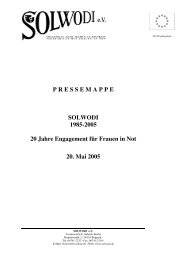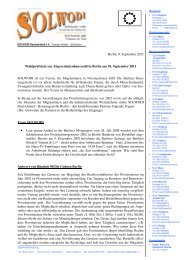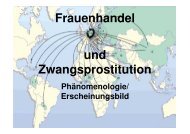Sponsored Vocational Training: Dream of Escape or Reality - Solwodi
Sponsored Vocational Training: Dream of Escape or Reality - Solwodi
Sponsored Vocational Training: Dream of Escape or Reality - Solwodi
You also want an ePaper? Increase the reach of your titles
YUMPU automatically turns print PDFs into web optimized ePapers that Google loves.
Efficacy <strong>of</strong> SOLWODI’s <strong>Vocational</strong> <strong>Training</strong> Scheme 22<br />
from the Kenyan Army while being on training. She decided to start w<strong>or</strong>king f<strong>or</strong> the Army<br />
instead <strong>of</strong> being enrolled in VT. Two other trainees were <strong>of</strong>fered jobs whilst on training, also<br />
dropped out.<br />
e) Current W<strong>or</strong>king Situation<br />
F<strong>or</strong> 33 percent (129 women) <strong>of</strong> all trainees inf<strong>or</strong>mation on their contemp<strong>or</strong>ary w<strong>or</strong>king<br />
situation is available. In 70 percent <strong>of</strong> the129 cases, trainees are w<strong>or</strong>king, either in their trained<br />
field (49 percent) <strong>or</strong> in another w<strong>or</strong>king area (21 percent). It would have been interesting<br />
whether some women had to go back to CSW in <strong>or</strong>der to make ends meet <strong>or</strong> not. However, it<br />
was not possible to retrieve this inf<strong>or</strong>mation.<br />
W<strong>or</strong>king inf<strong>or</strong>mation <strong>of</strong> 129 trainees<br />
YES, w<strong>or</strong>king in their VT field 63 (49%)<br />
YES, w<strong>or</strong>king but in another area (not SW) 27 (21%)<br />
N/A, still in VT 26 (20%)<br />
NO, not w<strong>or</strong>king 9 (7%)<br />
NO, deceased 4 (3%)<br />
Mombasa clients consist <strong>of</strong> 56 percent (216 trainees) <strong>of</strong> the total sample population.<br />
M<strong>or</strong>e w<strong>or</strong>k-related data was available on this sub-population, compared to women who lived in<br />
the coastal towns Malindi,<br />
Mtwapa and women who had<br />
been spons<strong>or</strong>ed by the 2005 ILO<br />
project. The number <strong>of</strong> dropouts<br />
in the sub-sample was higher (23<br />
percent) in contrast to 18 percent<br />
dropout ratio in the overall<br />
sample. From the Mombasa<br />
clients, 77 women (36 percent)<br />
are currently employed, six (3<br />
percent) are not w<strong>or</strong>king, whereas<br />
data on post-VT circumstances<br />
was not known f<strong>or</strong> 38 percent.<br />
Figure 3: Overall clients, incl. Mombasa sub-sample (Database Extract)






